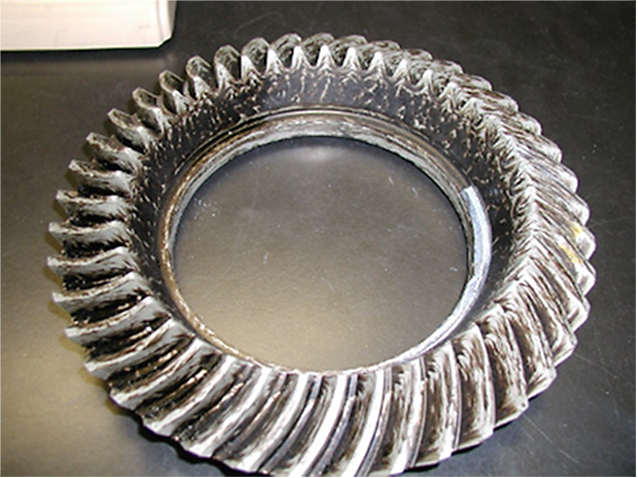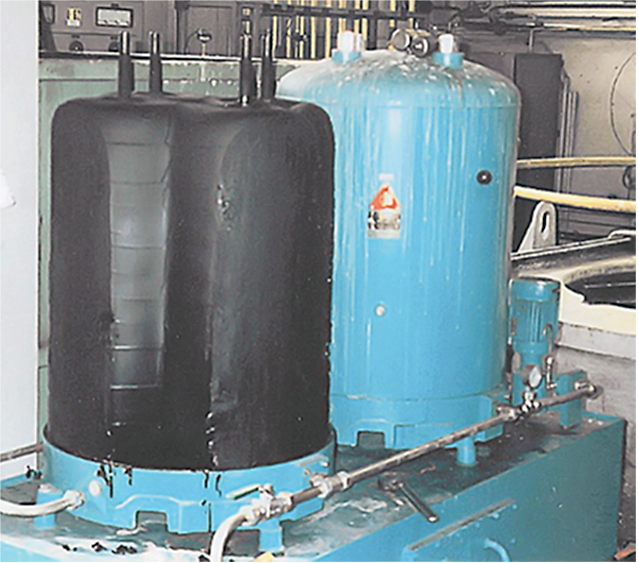
In this column, I will discuss the formation of sludge in a quench tank, its prevention, and removal.
Introduction
As a quench oil is used, it will oxidize. The degradation of quench oil is aggravated by residues on parts, washer residues from oil reclaimed from washers, high energy density heater or radiant tubes, and excessive peak temperatures. The addition of robust additive packages prolongs a quenchant life and provides for repeatable quenching.
Additive depletion is normal and expected. The antioxidants are consumed as part of their function. Antioxidants are replenished as make-up oil is added.
Oil degradation or oxidation is manifested by a viscosity increase, acidity increase (as measured by Total Acid Number), varnish and lacquer deposits, sludge, and changes in the quench speed [1]. I have covered the mechanism of oil oxidation in previous columns [2].
Condensation reactions and sludge and deposit formation
As oils become increasingly oxidized, whether in the quench tank or in oxidation tests, the viscosity increases. This occurs by condensation reactions that become important as the levels of aldehydes and ketones increase. These reactions are known as aldol condensations [3]. It is this reaction that causes varnish on parts and sludge in quench tanks (Figure 1).

The condensation products have a limited solubility in the quenchant. These are high molecular weight oligomers. These are molecules that have a few monomer units, in contrast to a polymer that can have an unlimited number of monomers. As oil oxidizes, the concentration of carboxylic acids will increase. These acids are very effective catalysts for aldol condensation reactions. These then convert the low molecular weight carbonyl compounds into higher molecular weight oligomers. It is these partially soluble high molecular weight oligomers that result in increased precipitation number and higher viscosity [4] [5].
As the reactions progress, chemical changes in the oligomers will result in making them insoluble in the quench oil. At this point, the insoluble oligomers will precipitate from the quench oil and create sludge on the bottom of the quench tank and deposits (“tiger striping”) on the hot metal part.
The higher kinetic rate of aromatic group oxidation increases sludge and deposits. Because paraffinic oils have fewer aromatic groups than naphthenic oils, paraffinic oils are preferred for quenchants. Metal scale and soot, base oil sulfur, and additive sulfur can also promote the formation of sludge and deposits. Soot can also act as a nucleation site for the formation of oligomers, resulting in soot particles coated in oligomers. These accumulate at the bottom of the quench tank in low velocity areas and are deposited on parts.
Prevention
The easiest way to remove sludge and oxidation from the bottom of a quench tank is to prevent the formation of sludge, or by filtering sludge and scale before it deposits [5] [6]. Filtering is very effective in reducing staining and preventing “tiger-striping” on parts [7]. However, the size of the filter matters. Bag filters of 50-75 micron size, are a waste of time and effort [6]. Only when filtration becomes finer do the benefits of filtration become apparent. Staged filtration is best, with progressively finer filtration. While bag filtration is cheap, cartridge filtration is capable of much deeper filtration, and can go much longer between changes. (Figure 2) Depending on the filter media, water removal is also possible.

Centrifuging the oil is a viable option. However, it is not always able to remove the very fine particulate and oxidation precursors that are soluble in the oil. Centrifuges are expensive and are also maintenance prone. They are also difficult to clean, being a very messy job.
The preferred solution is to use fine filtration after a new charge of quenchant. This ensures that fine filtration is achieved throughout the life of the oil, and not after the oil is badly oxidized.
Removal
First, the oxidized oil is pumped out of the quench tank into totes or a separate storage tank for reclamation or disposal. This residual oil can often be reclaimed by filtering using an outside contractor and new additive added to the quenchant [8]. Typically, when out-sourcing recycling oil, the cost can be 25-75 percent of new oil, depending on the condition of the oil.
Removal of sludge from a quench tank is a messy and dirty job. Depending on the extent of oxidation and the size of the quench tank, the sludge can be inches or feet thick. Good removal of the sludge often requires maintenance workers to climb into the quench tank and literally shovel out the oily sludge. This often requires enclosed space inspection and permits, with a breathing supply of oxygen for the workers. Because of the oily nature of the sludge, operators require full Tyvek suits, boots, and gloves. This is a very time-consuming, hot, and laborious job.
Depending on the extent of the sludge, high-powered pumps can remove much of the sludge from the quench tank. While this can remove much of the sludge, it cannot remove all the sludge from quenching mechanisms, agitators, and quench tank walls. Depending on the application and the extent of sludge present, this may be adequate. However, the preferred solution is to properly clean the quench tank.
After shoveling and otherwise scraping sludge from the quench tank, there is still a lot of sludge remaining that it is not possible to remove. In this case, the use of pressure washers, using a 1-2 percent solution of high detergency cleaner is recommended. Solvents can be used, but the risk of contaminating the quench oil is very high. This can result in a lowered flashpoint and reduced viscosity. Any solvent present can oxidize rapidly, and initiate oxidation of the quench oil.
While use of water and a cleaner can be problematic if residual water is left in the quench tank, this can be overcome with heating the new charge slowly to above 212°F and allowing the water to be driven off from the oil. Testing to verify that water has been removed is recommended prior to initiating quenching. Due to the risks of using either solvent or water to remove the last remnants of sludge, this last step of using either a solvent or pressure washing is often skipped.
Once the quench tank has been cleaned adequately, the new quench oil is added, allowing for expansion of oil during heating [9].
 Conclusions
Conclusions
In this column, I have discussed the formation of sludge and its prevention. Lastly, the methods to remove sludge from a quench tank were described.
Should there be any questions regarding this article, or topic suggestions for new articles, please contact the writer or the editor.
References
- G. Totten, C. Bates and N. Clinton, Eds., Handbook of Quenching and Quenchants, Metals Park, OH: ASM International, 1993.
- D. S. MacKenzie, “Oil Quenchants — Understanding the Chemistry (Part III),” Gear Solutions, pp. 24-26, March 2018.
- J. March, “The Aldol Condensation,” in Advanced Organic Chemistry, New York, John Wiley & Sons, 1985, pp. 829-834.
- D. S. MacKenzie, “The Mechanism of Oil Oxidation,” in Proc. 2nd Mediterranean Conference on Heat Treatment and Surface Engineering, 15 June 2014, Dubrovnik, Croatia, 2014.
- E. Rowland and D. S. MacKenzie, “Proper Care of Quench Oil Leading to Consistent Part Quality,” in Thermal Processing in Motion 2018—Conference Proceedings of the Thermal Processing in Motion, Spartanburg, South Carolina, USA , 2018.
- G. Steiger and M. Bennett, “Obliterate Quench Contaminates,” Heat Treat Today, pp. 16-21, November 2023.
- D. S. MacKenzie, “Care and Maintenance of Oil Quenchants used for Quenching Automotive Components,” in European Conference on Heat Treatment and Surface Engineering, 11-13 May, Prague, Czech Republic, 2016.
- D. S. MacKenzie, “Reclamation and recycling of quench oil,” Gear Solutions, pp. 34-35, September 2019.
- D. S. MacKenzie, “Thermal expansion of mineral oil quenchants,” Thermal Processing, pp. 26-27, April 2024.






















